Special Needs Students in Singapore Education System
VerifiedAdded on 2023/01/18
|24
|7386
|24
Report
AI Summary
This research proposal investigates the challenges and experiences of Special Education Needs (SEN) students within the Singapore mainstream education system. It explores the issues faced by children with autism spectrum disorder, including difficulties in learning, interaction, and communication. The proposal examines the obstacles to inclusive education, such as social stigma, lack of assistive technology, and teacher competency. It delves into the challenges of SEN students in primary schools, focusing on school refusal, repetitive behaviors, and fragmented support systems. The research also addresses the lack of resources, teacher training, and the impact of these factors on the inclusion of SEN students. The study aims to understand the perspectives of teachers and school staff, identify gaps in the mainstream education structure, and propose potential solutions to improve the learning environment and outcomes for SEN students in Singapore. The research methodology includes a theoretical framework, research design, data collection methods, data analysis techniques, and expected outcomes, along with limitations of the study.
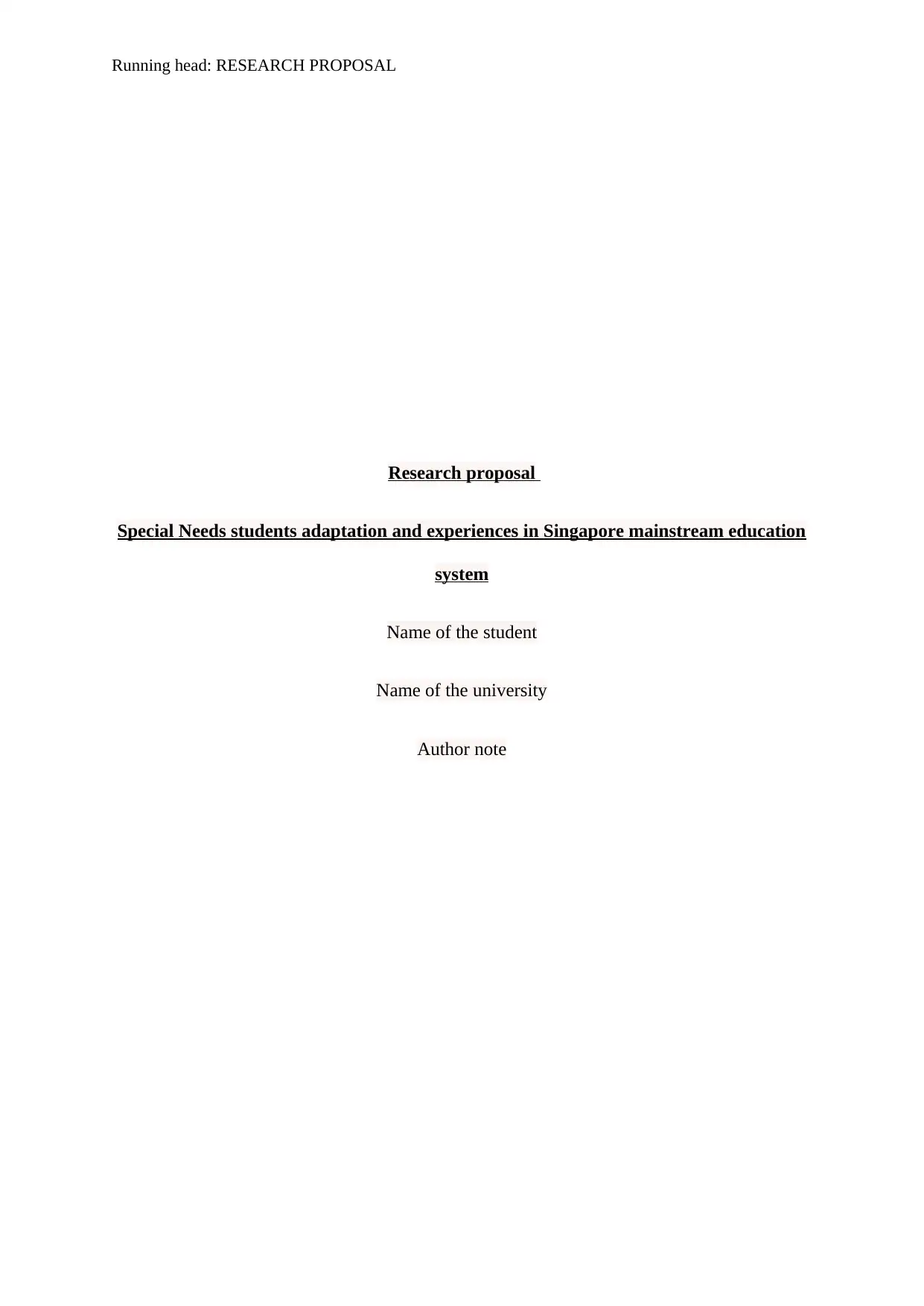
Running head: RESEARCH PROPOSAL
Research proposal
Special Needs students adaptation and experiences in Singapore mainstream education
system
Name of the student
Name of the university
Author note
Research proposal
Special Needs students adaptation and experiences in Singapore mainstream education
system
Name of the student
Name of the university
Author note
Paraphrase This Document
Need a fresh take? Get an instant paraphrase of this document with our AI Paraphraser
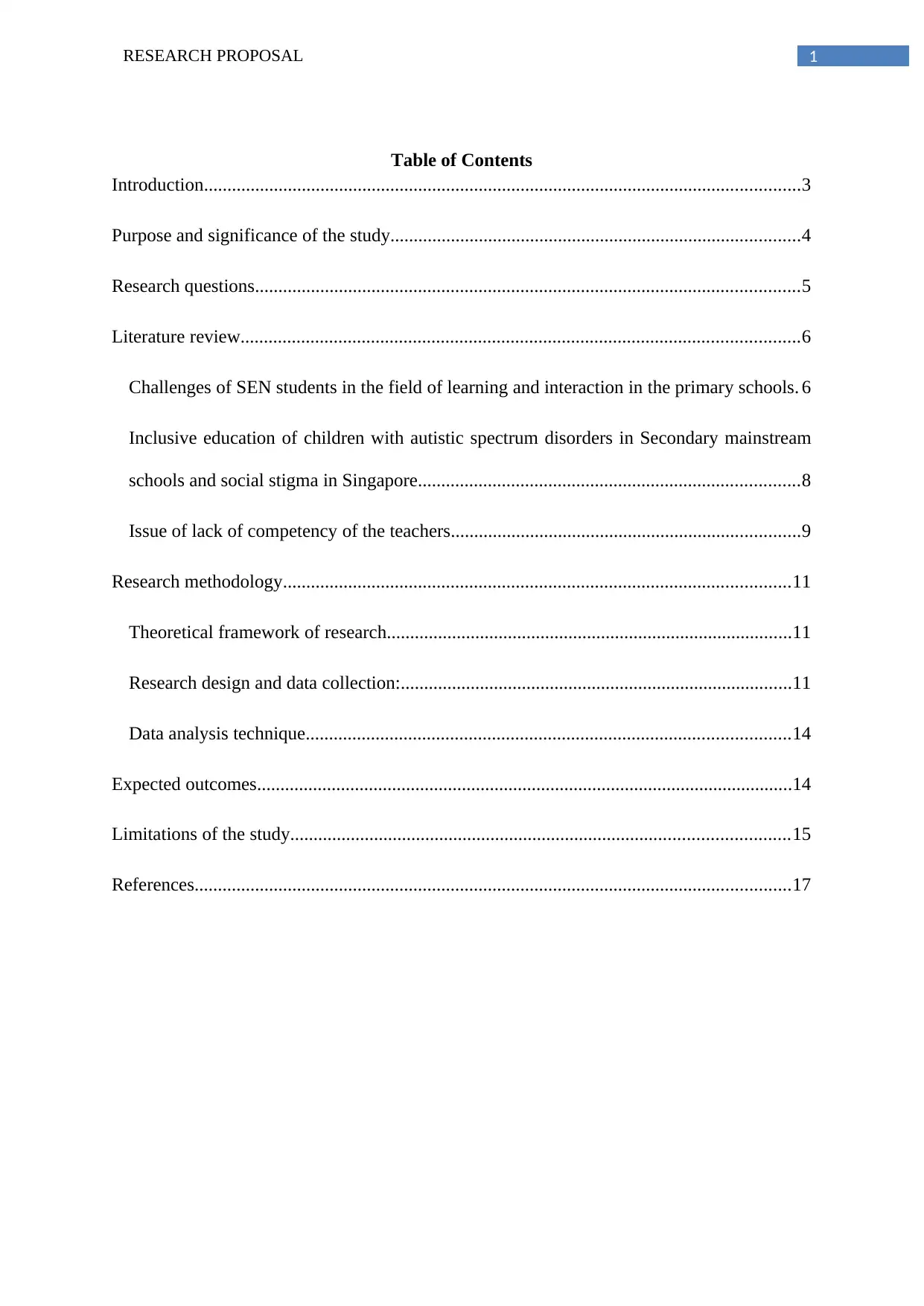
1RESEARCH PROPOSAL
Table of Contents
Introduction................................................................................................................................3
Purpose and significance of the study........................................................................................4
Research questions.....................................................................................................................5
Literature review........................................................................................................................6
Challenges of SEN students in the field of learning and interaction in the primary schools. 6
Inclusive education of children with autistic spectrum disorders in Secondary mainstream
schools and social stigma in Singapore..................................................................................8
Issue of lack of competency of the teachers...........................................................................9
Research methodology.............................................................................................................11
Theoretical framework of research.......................................................................................11
Research design and data collection:....................................................................................11
Data analysis technique........................................................................................................14
Expected outcomes...................................................................................................................14
Limitations of the study...........................................................................................................15
References................................................................................................................................17
Table of Contents
Introduction................................................................................................................................3
Purpose and significance of the study........................................................................................4
Research questions.....................................................................................................................5
Literature review........................................................................................................................6
Challenges of SEN students in the field of learning and interaction in the primary schools. 6
Inclusive education of children with autistic spectrum disorders in Secondary mainstream
schools and social stigma in Singapore..................................................................................8
Issue of lack of competency of the teachers...........................................................................9
Research methodology.............................................................................................................11
Theoretical framework of research.......................................................................................11
Research design and data collection:....................................................................................11
Data analysis technique........................................................................................................14
Expected outcomes...................................................................................................................14
Limitations of the study...........................................................................................................15
References................................................................................................................................17
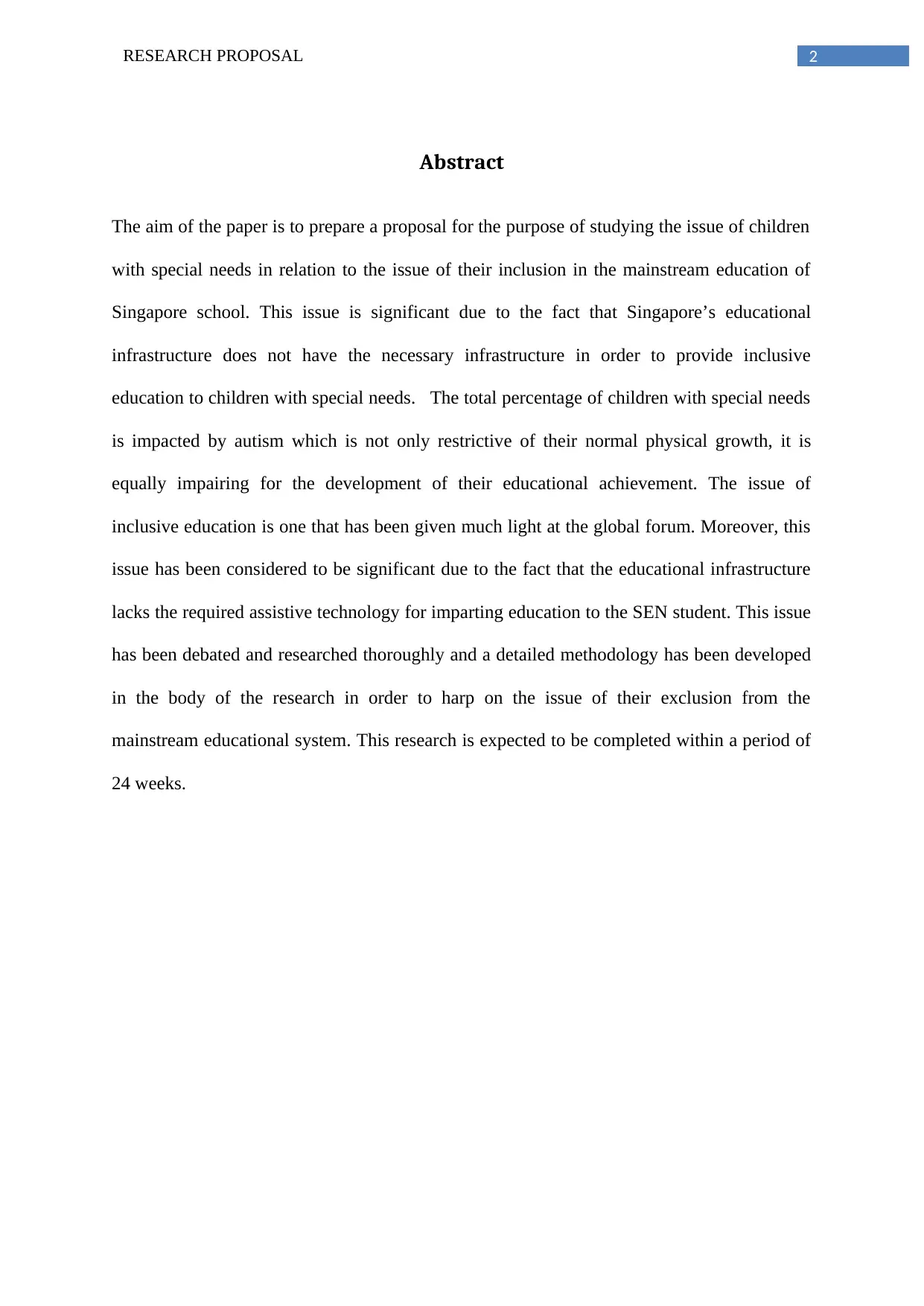
2RESEARCH PROPOSAL
Abstract
The aim of the paper is to prepare a proposal for the purpose of studying the issue of children
with special needs in relation to the issue of their inclusion in the mainstream education of
Singapore school. This issue is significant due to the fact that Singapore’s educational
infrastructure does not have the necessary infrastructure in order to provide inclusive
education to children with special needs. The total percentage of children with special needs
is impacted by autism which is not only restrictive of their normal physical growth, it is
equally impairing for the development of their educational achievement. The issue of
inclusive education is one that has been given much light at the global forum. Moreover, this
issue has been considered to be significant due to the fact that the educational infrastructure
lacks the required assistive technology for imparting education to the SEN student. This issue
has been debated and researched thoroughly and a detailed methodology has been developed
in the body of the research in order to harp on the issue of their exclusion from the
mainstream educational system. This research is expected to be completed within a period of
24 weeks.
Abstract
The aim of the paper is to prepare a proposal for the purpose of studying the issue of children
with special needs in relation to the issue of their inclusion in the mainstream education of
Singapore school. This issue is significant due to the fact that Singapore’s educational
infrastructure does not have the necessary infrastructure in order to provide inclusive
education to children with special needs. The total percentage of children with special needs
is impacted by autism which is not only restrictive of their normal physical growth, it is
equally impairing for the development of their educational achievement. The issue of
inclusive education is one that has been given much light at the global forum. Moreover, this
issue has been considered to be significant due to the fact that the educational infrastructure
lacks the required assistive technology for imparting education to the SEN student. This issue
has been debated and researched thoroughly and a detailed methodology has been developed
in the body of the research in order to harp on the issue of their exclusion from the
mainstream educational system. This research is expected to be completed within a period of
24 weeks.
⊘ This is a preview!⊘
Do you want full access?
Subscribe today to unlock all pages.

Trusted by 1+ million students worldwide
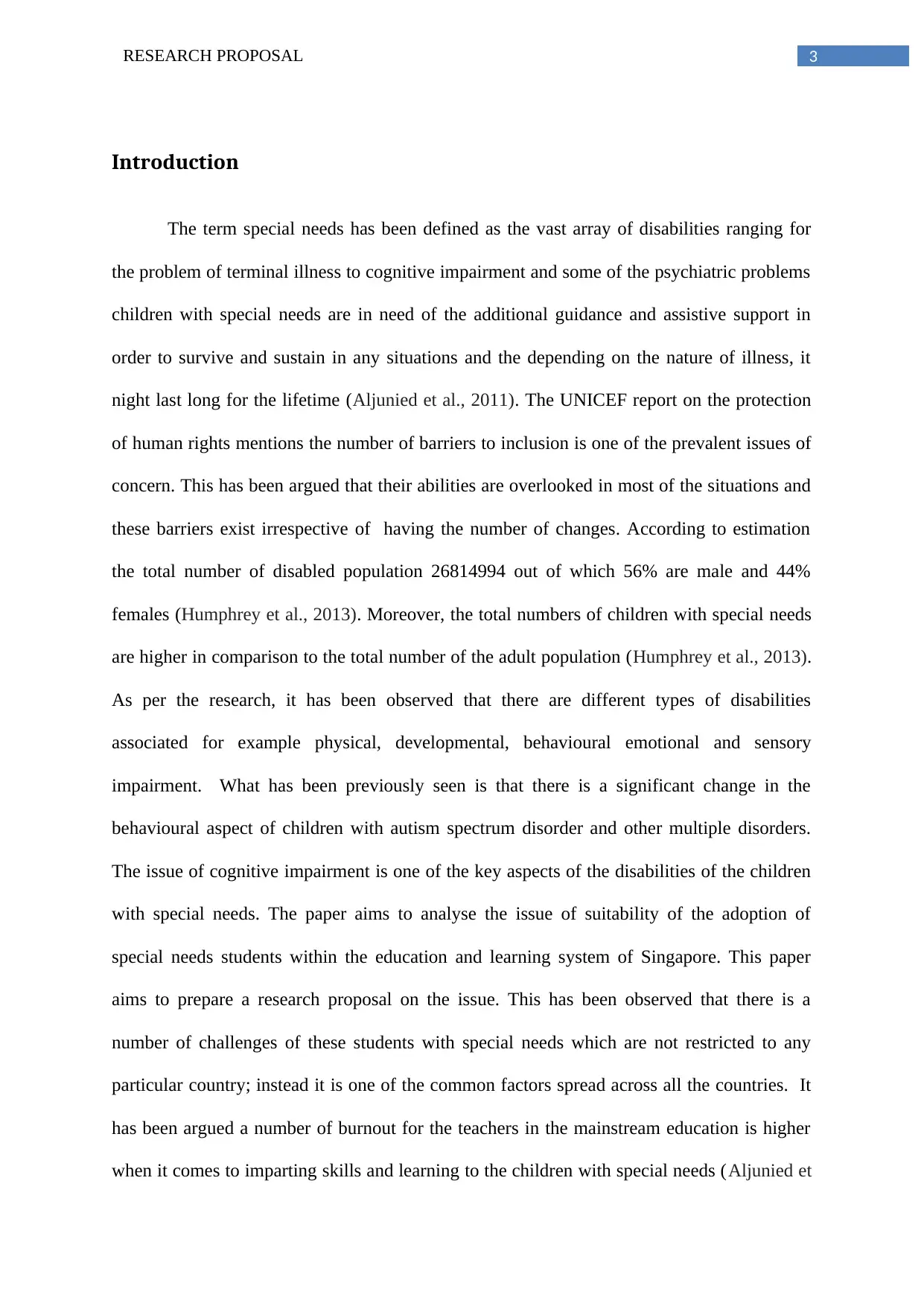
3RESEARCH PROPOSAL
Introduction
The term special needs has been defined as the vast array of disabilities ranging for
the problem of terminal illness to cognitive impairment and some of the psychiatric problems
children with special needs are in need of the additional guidance and assistive support in
order to survive and sustain in any situations and the depending on the nature of illness, it
night last long for the lifetime (Aljunied et al., 2011). The UNICEF report on the protection
of human rights mentions the number of barriers to inclusion is one of the prevalent issues of
concern. This has been argued that their abilities are overlooked in most of the situations and
these barriers exist irrespective of having the number of changes. According to estimation
the total number of disabled population 26814994 out of which 56% are male and 44%
females (Humphrey et al., 2013). Moreover, the total numbers of children with special needs
are higher in comparison to the total number of the adult population (Humphrey et al., 2013).
As per the research, it has been observed that there are different types of disabilities
associated for example physical, developmental, behavioural emotional and sensory
impairment. What has been previously seen is that there is a significant change in the
behavioural aspect of children with autism spectrum disorder and other multiple disorders.
The issue of cognitive impairment is one of the key aspects of the disabilities of the children
with special needs. The paper aims to analyse the issue of suitability of the adoption of
special needs students within the education and learning system of Singapore. This paper
aims to prepare a research proposal on the issue. This has been observed that there is a
number of challenges of these students with special needs which are not restricted to any
particular country; instead it is one of the common factors spread across all the countries. It
has been argued a number of burnout for the teachers in the mainstream education is higher
when it comes to imparting skills and learning to the children with special needs (Aljunied et
Introduction
The term special needs has been defined as the vast array of disabilities ranging for
the problem of terminal illness to cognitive impairment and some of the psychiatric problems
children with special needs are in need of the additional guidance and assistive support in
order to survive and sustain in any situations and the depending on the nature of illness, it
night last long for the lifetime (Aljunied et al., 2011). The UNICEF report on the protection
of human rights mentions the number of barriers to inclusion is one of the prevalent issues of
concern. This has been argued that their abilities are overlooked in most of the situations and
these barriers exist irrespective of having the number of changes. According to estimation
the total number of disabled population 26814994 out of which 56% are male and 44%
females (Humphrey et al., 2013). Moreover, the total numbers of children with special needs
are higher in comparison to the total number of the adult population (Humphrey et al., 2013).
As per the research, it has been observed that there are different types of disabilities
associated for example physical, developmental, behavioural emotional and sensory
impairment. What has been previously seen is that there is a significant change in the
behavioural aspect of children with autism spectrum disorder and other multiple disorders.
The issue of cognitive impairment is one of the key aspects of the disabilities of the children
with special needs. The paper aims to analyse the issue of suitability of the adoption of
special needs students within the education and learning system of Singapore. This paper
aims to prepare a research proposal on the issue. This has been observed that there is a
number of challenges of these students with special needs which are not restricted to any
particular country; instead it is one of the common factors spread across all the countries. It
has been argued a number of burnout for the teachers in the mainstream education is higher
when it comes to imparting skills and learning to the children with special needs (Aljunied et
Paraphrase This Document
Need a fresh take? Get an instant paraphrase of this document with our AI Paraphraser
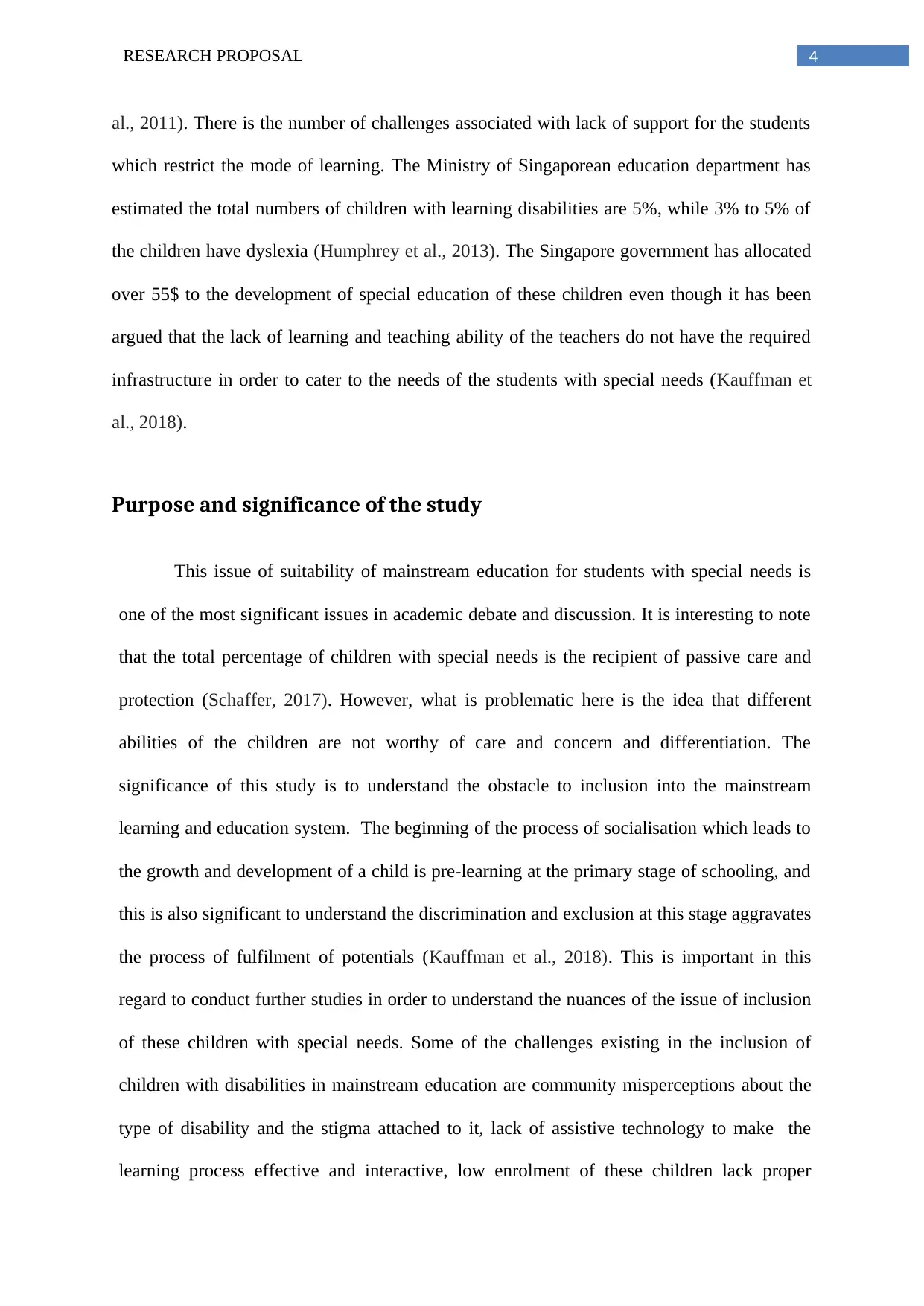
4RESEARCH PROPOSAL
al., 2011). There is the number of challenges associated with lack of support for the students
which restrict the mode of learning. The Ministry of Singaporean education department has
estimated the total numbers of children with learning disabilities are 5%, while 3% to 5% of
the children have dyslexia (Humphrey et al., 2013). The Singapore government has allocated
over 55$ to the development of special education of these children even though it has been
argued that the lack of learning and teaching ability of the teachers do not have the required
infrastructure in order to cater to the needs of the students with special needs (Kauffman et
al., 2018).
Purpose and significance of the study
This issue of suitability of mainstream education for students with special needs is
one of the most significant issues in academic debate and discussion. It is interesting to note
that the total percentage of children with special needs is the recipient of passive care and
protection (Schaffer, 2017). However, what is problematic here is the idea that different
abilities of the children are not worthy of care and concern and differentiation. The
significance of this study is to understand the obstacle to inclusion into the mainstream
learning and education system. The beginning of the process of socialisation which leads to
the growth and development of a child is pre-learning at the primary stage of schooling, and
this is also significant to understand the discrimination and exclusion at this stage aggravates
the process of fulfilment of potentials (Kauffman et al., 2018). This is important in this
regard to conduct further studies in order to understand the nuances of the issue of inclusion
of these children with special needs. Some of the challenges existing in the inclusion of
children with disabilities in mainstream education are community misperceptions about the
type of disability and the stigma attached to it, lack of assistive technology to make the
learning process effective and interactive, low enrolment of these children lack proper
al., 2011). There is the number of challenges associated with lack of support for the students
which restrict the mode of learning. The Ministry of Singaporean education department has
estimated the total numbers of children with learning disabilities are 5%, while 3% to 5% of
the children have dyslexia (Humphrey et al., 2013). The Singapore government has allocated
over 55$ to the development of special education of these children even though it has been
argued that the lack of learning and teaching ability of the teachers do not have the required
infrastructure in order to cater to the needs of the students with special needs (Kauffman et
al., 2018).
Purpose and significance of the study
This issue of suitability of mainstream education for students with special needs is
one of the most significant issues in academic debate and discussion. It is interesting to note
that the total percentage of children with special needs is the recipient of passive care and
protection (Schaffer, 2017). However, what is problematic here is the idea that different
abilities of the children are not worthy of care and concern and differentiation. The
significance of this study is to understand the obstacle to inclusion into the mainstream
learning and education system. The beginning of the process of socialisation which leads to
the growth and development of a child is pre-learning at the primary stage of schooling, and
this is also significant to understand the discrimination and exclusion at this stage aggravates
the process of fulfilment of potentials (Kauffman et al., 2018). This is important in this
regard to conduct further studies in order to understand the nuances of the issue of inclusion
of these children with special needs. Some of the challenges existing in the inclusion of
children with disabilities in mainstream education are community misperceptions about the
type of disability and the stigma attached to it, lack of assistive technology to make the
learning process effective and interactive, low enrolment of these children lack proper
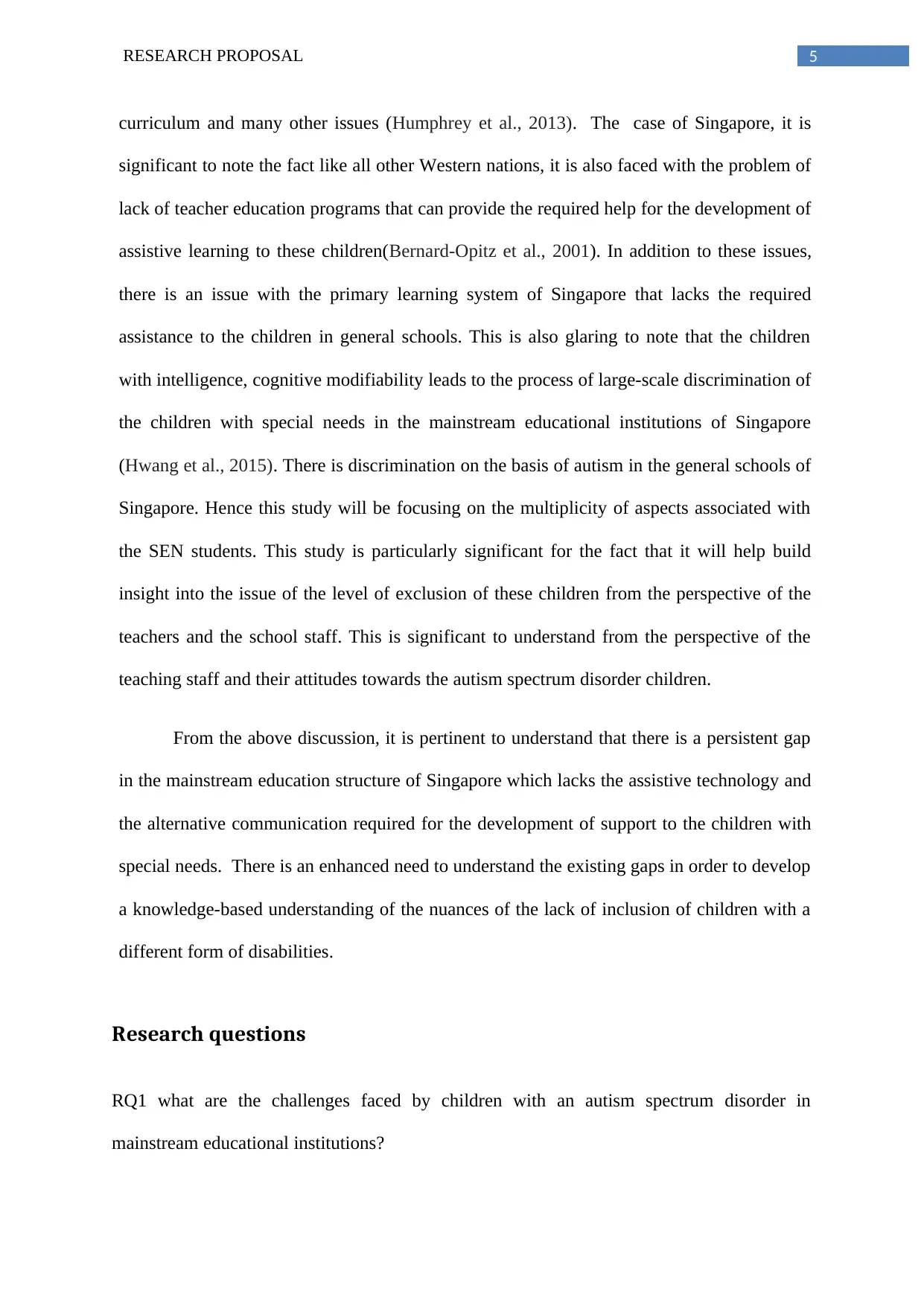
5RESEARCH PROPOSAL
curriculum and many other issues (Humphrey et al., 2013). The case of Singapore, it is
significant to note the fact like all other Western nations, it is also faced with the problem of
lack of teacher education programs that can provide the required help for the development of
assistive learning to these children(Bernard-Opitz et al., 2001). In addition to these issues,
there is an issue with the primary learning system of Singapore that lacks the required
assistance to the children in general schools. This is also glaring to note that the children
with intelligence, cognitive modifiability leads to the process of large-scale discrimination of
the children with special needs in the mainstream educational institutions of Singapore
(Hwang et al., 2015). There is discrimination on the basis of autism in the general schools of
Singapore. Hence this study will be focusing on the multiplicity of aspects associated with
the SEN students. This study is particularly significant for the fact that it will help build
insight into the issue of the level of exclusion of these children from the perspective of the
teachers and the school staff. This is significant to understand from the perspective of the
teaching staff and their attitudes towards the autism spectrum disorder children.
From the above discussion, it is pertinent to understand that there is a persistent gap
in the mainstream education structure of Singapore which lacks the assistive technology and
the alternative communication required for the development of support to the children with
special needs. There is an enhanced need to understand the existing gaps in order to develop
a knowledge-based understanding of the nuances of the lack of inclusion of children with a
different form of disabilities.
Research questions
RQ1 what are the challenges faced by children with an autism spectrum disorder in
mainstream educational institutions?
curriculum and many other issues (Humphrey et al., 2013). The case of Singapore, it is
significant to note the fact like all other Western nations, it is also faced with the problem of
lack of teacher education programs that can provide the required help for the development of
assistive learning to these children(Bernard-Opitz et al., 2001). In addition to these issues,
there is an issue with the primary learning system of Singapore that lacks the required
assistance to the children in general schools. This is also glaring to note that the children
with intelligence, cognitive modifiability leads to the process of large-scale discrimination of
the children with special needs in the mainstream educational institutions of Singapore
(Hwang et al., 2015). There is discrimination on the basis of autism in the general schools of
Singapore. Hence this study will be focusing on the multiplicity of aspects associated with
the SEN students. This study is particularly significant for the fact that it will help build
insight into the issue of the level of exclusion of these children from the perspective of the
teachers and the school staff. This is significant to understand from the perspective of the
teaching staff and their attitudes towards the autism spectrum disorder children.
From the above discussion, it is pertinent to understand that there is a persistent gap
in the mainstream education structure of Singapore which lacks the assistive technology and
the alternative communication required for the development of support to the children with
special needs. There is an enhanced need to understand the existing gaps in order to develop
a knowledge-based understanding of the nuances of the lack of inclusion of children with a
different form of disabilities.
Research questions
RQ1 what are the challenges faced by children with an autism spectrum disorder in
mainstream educational institutions?
⊘ This is a preview!⊘
Do you want full access?
Subscribe today to unlock all pages.

Trusted by 1+ million students worldwide
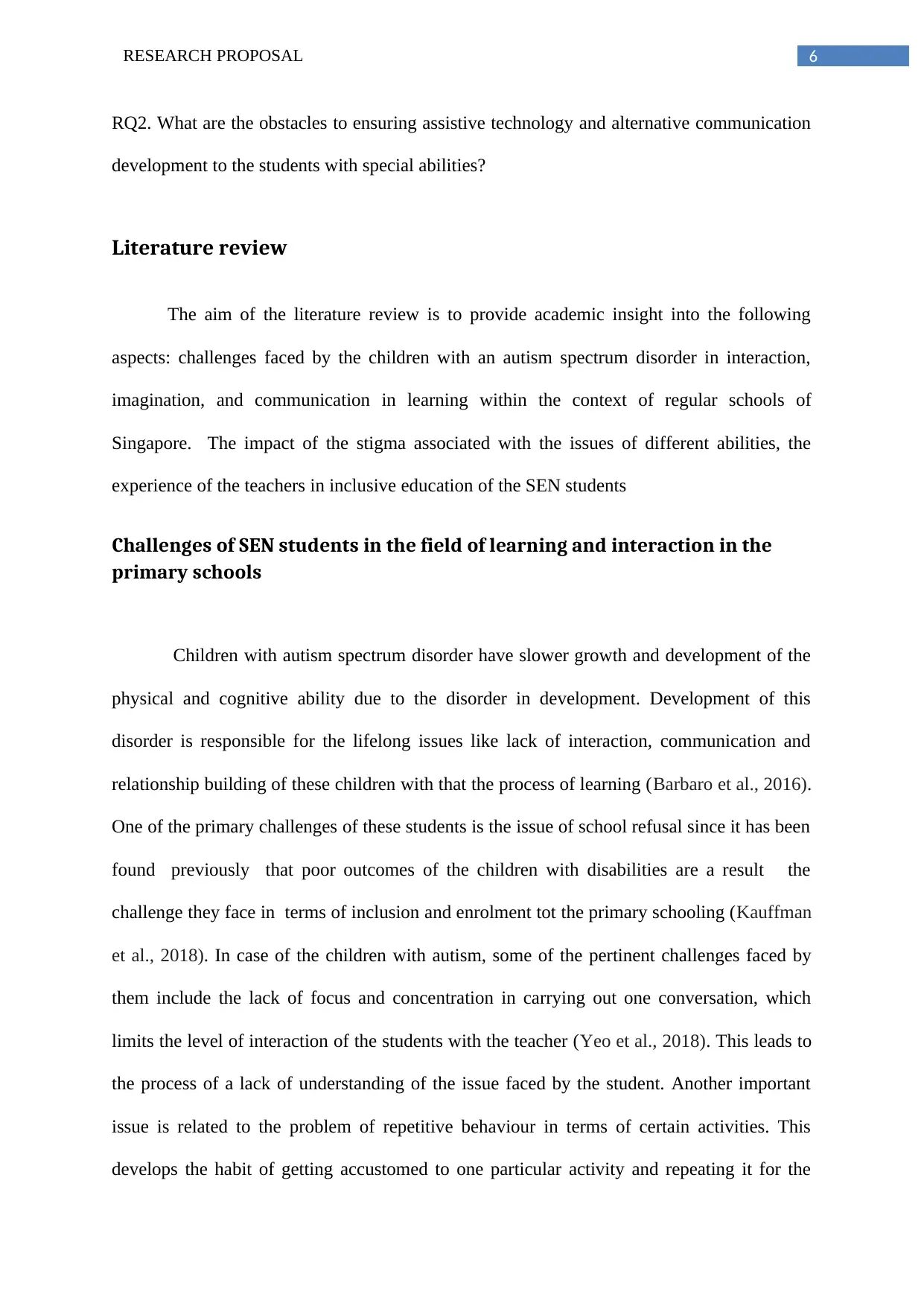
6RESEARCH PROPOSAL
RQ2. What are the obstacles to ensuring assistive technology and alternative communication
development to the students with special abilities?
Literature review
The aim of the literature review is to provide academic insight into the following
aspects: challenges faced by the children with an autism spectrum disorder in interaction,
imagination, and communication in learning within the context of regular schools of
Singapore. The impact of the stigma associated with the issues of different abilities, the
experience of the teachers in inclusive education of the SEN students
Challenges of SEN students in the field of learning and interaction in the
primary schools
Children with autism spectrum disorder have slower growth and development of the
physical and cognitive ability due to the disorder in development. Development of this
disorder is responsible for the lifelong issues like lack of interaction, communication and
relationship building of these children with that the process of learning (Barbaro et al., 2016).
One of the primary challenges of these students is the issue of school refusal since it has been
found previously that poor outcomes of the children with disabilities are a result the
challenge they face in terms of inclusion and enrolment tot the primary schooling (Kauffman
et al., 2018). In case of the children with autism, some of the pertinent challenges faced by
them include the lack of focus and concentration in carrying out one conversation, which
limits the level of interaction of the students with the teacher (Yeo et al., 2018). This leads to
the process of a lack of understanding of the issue faced by the student. Another important
issue is related to the problem of repetitive behaviour in terms of certain activities. This
develops the habit of getting accustomed to one particular activity and repeating it for the
RQ2. What are the obstacles to ensuring assistive technology and alternative communication
development to the students with special abilities?
Literature review
The aim of the literature review is to provide academic insight into the following
aspects: challenges faced by the children with an autism spectrum disorder in interaction,
imagination, and communication in learning within the context of regular schools of
Singapore. The impact of the stigma associated with the issues of different abilities, the
experience of the teachers in inclusive education of the SEN students
Challenges of SEN students in the field of learning and interaction in the
primary schools
Children with autism spectrum disorder have slower growth and development of the
physical and cognitive ability due to the disorder in development. Development of this
disorder is responsible for the lifelong issues like lack of interaction, communication and
relationship building of these children with that the process of learning (Barbaro et al., 2016).
One of the primary challenges of these students is the issue of school refusal since it has been
found previously that poor outcomes of the children with disabilities are a result the
challenge they face in terms of inclusion and enrolment tot the primary schooling (Kauffman
et al., 2018). In case of the children with autism, some of the pertinent challenges faced by
them include the lack of focus and concentration in carrying out one conversation, which
limits the level of interaction of the students with the teacher (Yeo et al., 2018). This leads to
the process of a lack of understanding of the issue faced by the student. Another important
issue is related to the problem of repetitive behaviour in terms of certain activities. This
develops the habit of getting accustomed to one particular activity and repeating it for the
Paraphrase This Document
Need a fresh take? Get an instant paraphrase of this document with our AI Paraphraser
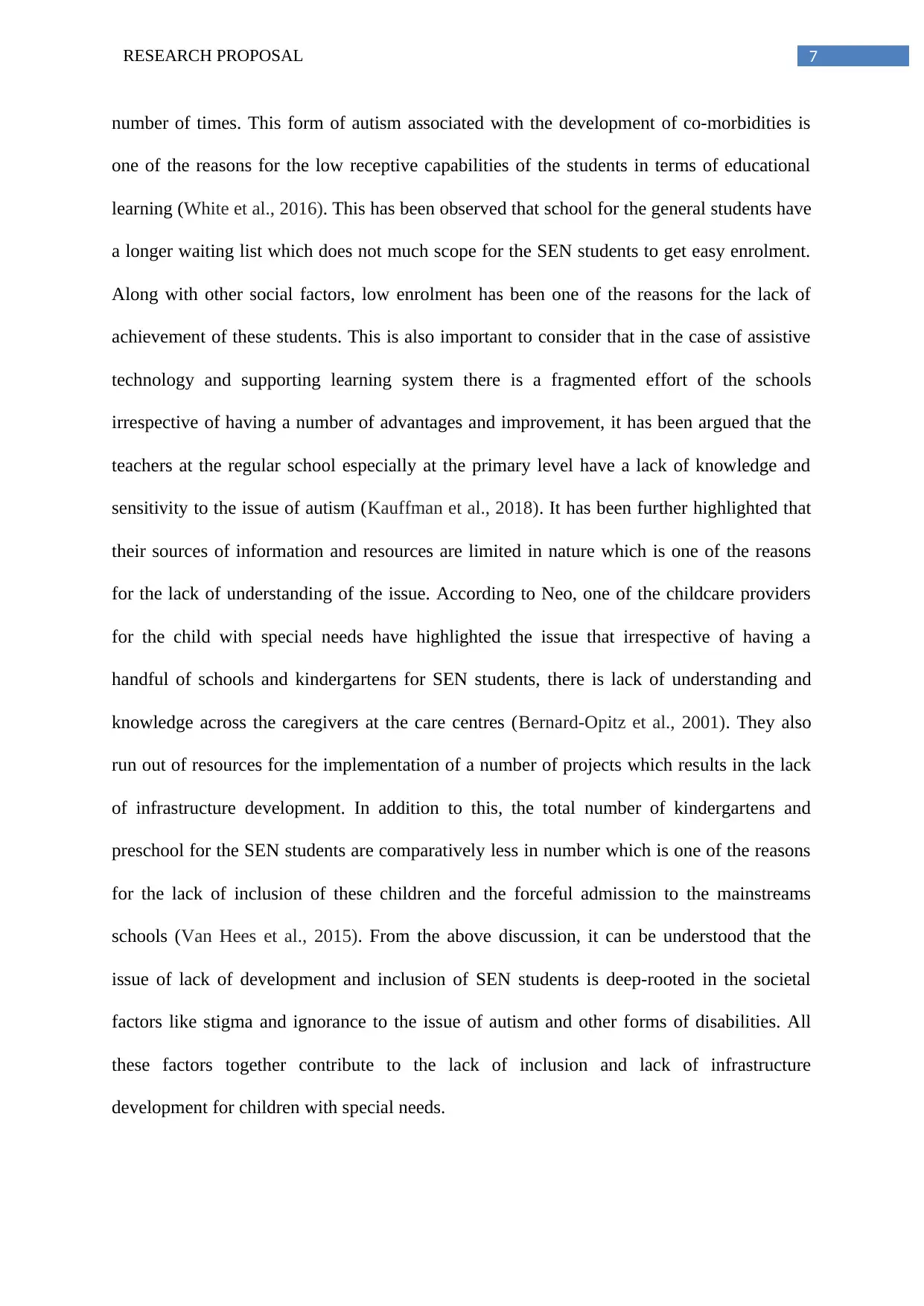
7RESEARCH PROPOSAL
number of times. This form of autism associated with the development of co-morbidities is
one of the reasons for the low receptive capabilities of the students in terms of educational
learning (White et al., 2016). This has been observed that school for the general students have
a longer waiting list which does not much scope for the SEN students to get easy enrolment.
Along with other social factors, low enrolment has been one of the reasons for the lack of
achievement of these students. This is also important to consider that in the case of assistive
technology and supporting learning system there is a fragmented effort of the schools
irrespective of having a number of advantages and improvement, it has been argued that the
teachers at the regular school especially at the primary level have a lack of knowledge and
sensitivity to the issue of autism (Kauffman et al., 2018). It has been further highlighted that
their sources of information and resources are limited in nature which is one of the reasons
for the lack of understanding of the issue. According to Neo, one of the childcare providers
for the child with special needs have highlighted the issue that irrespective of having a
handful of schools and kindergartens for SEN students, there is lack of understanding and
knowledge across the caregivers at the care centres (Bernard-Opitz et al., 2001). They also
run out of resources for the implementation of a number of projects which results in the lack
of infrastructure development. In addition to this, the total number of kindergartens and
preschool for the SEN students are comparatively less in number which is one of the reasons
for the lack of inclusion of these children and the forceful admission to the mainstreams
schools (Van Hees et al., 2015). From the above discussion, it can be understood that the
issue of lack of development and inclusion of SEN students is deep-rooted in the societal
factors like stigma and ignorance to the issue of autism and other forms of disabilities. All
these factors together contribute to the lack of inclusion and lack of infrastructure
development for children with special needs.
number of times. This form of autism associated with the development of co-morbidities is
one of the reasons for the low receptive capabilities of the students in terms of educational
learning (White et al., 2016). This has been observed that school for the general students have
a longer waiting list which does not much scope for the SEN students to get easy enrolment.
Along with other social factors, low enrolment has been one of the reasons for the lack of
achievement of these students. This is also important to consider that in the case of assistive
technology and supporting learning system there is a fragmented effort of the schools
irrespective of having a number of advantages and improvement, it has been argued that the
teachers at the regular school especially at the primary level have a lack of knowledge and
sensitivity to the issue of autism (Kauffman et al., 2018). It has been further highlighted that
their sources of information and resources are limited in nature which is one of the reasons
for the lack of understanding of the issue. According to Neo, one of the childcare providers
for the child with special needs have highlighted the issue that irrespective of having a
handful of schools and kindergartens for SEN students, there is lack of understanding and
knowledge across the caregivers at the care centres (Bernard-Opitz et al., 2001). They also
run out of resources for the implementation of a number of projects which results in the lack
of infrastructure development. In addition to this, the total number of kindergartens and
preschool for the SEN students are comparatively less in number which is one of the reasons
for the lack of inclusion of these children and the forceful admission to the mainstreams
schools (Van Hees et al., 2015). From the above discussion, it can be understood that the
issue of lack of development and inclusion of SEN students is deep-rooted in the societal
factors like stigma and ignorance to the issue of autism and other forms of disabilities. All
these factors together contribute to the lack of inclusion and lack of infrastructure
development for children with special needs.
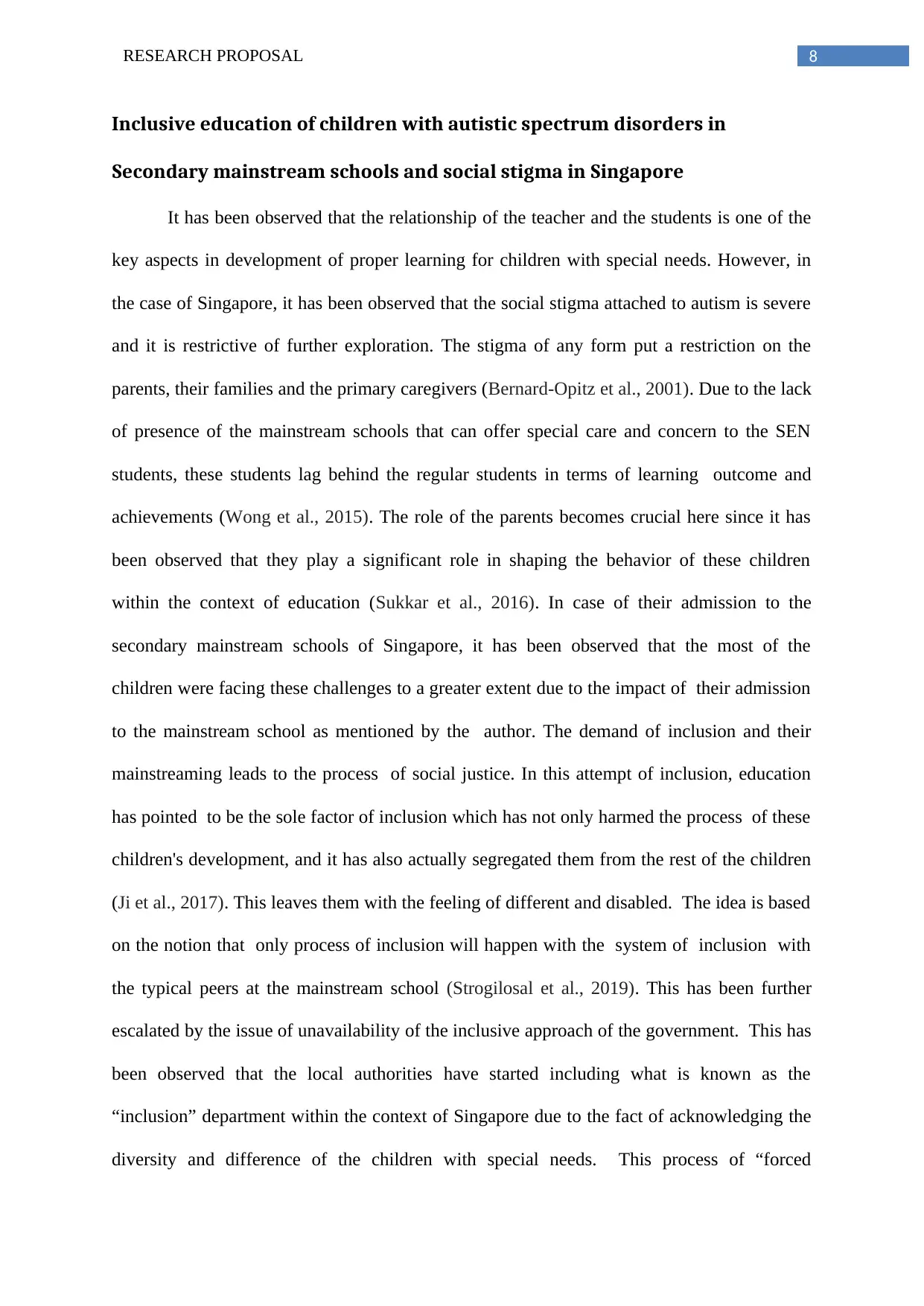
8RESEARCH PROPOSAL
Inclusive education of children with autistic spectrum disorders in
Secondary mainstream schools and social stigma in Singapore
It has been observed that the relationship of the teacher and the students is one of the
key aspects in development of proper learning for children with special needs. However, in
the case of Singapore, it has been observed that the social stigma attached to autism is severe
and it is restrictive of further exploration. The stigma of any form put a restriction on the
parents, their families and the primary caregivers (Bernard-Opitz et al., 2001). Due to the lack
of presence of the mainstream schools that can offer special care and concern to the SEN
students, these students lag behind the regular students in terms of learning outcome and
achievements (Wong et al., 2015). The role of the parents becomes crucial here since it has
been observed that they play a significant role in shaping the behavior of these children
within the context of education (Sukkar et al., 2016). In case of their admission to the
secondary mainstream schools of Singapore, it has been observed that the most of the
children were facing these challenges to a greater extent due to the impact of their admission
to the mainstream school as mentioned by the author. The demand of inclusion and their
mainstreaming leads to the process of social justice. In this attempt of inclusion, education
has pointed to be the sole factor of inclusion which has not only harmed the process of these
children's development, and it has also actually segregated them from the rest of the children
(Ji et al., 2017). This leaves them with the feeling of different and disabled. The idea is based
on the notion that only process of inclusion will happen with the system of inclusion with
the typical peers at the mainstream school (Strogilosal et al., 2019). This has been further
escalated by the issue of unavailability of the inclusive approach of the government. This has
been observed that the local authorities have started including what is known as the
“inclusion” department within the context of Singapore due to the fact of acknowledging the
diversity and difference of the children with special needs. This process of “forced
Inclusive education of children with autistic spectrum disorders in
Secondary mainstream schools and social stigma in Singapore
It has been observed that the relationship of the teacher and the students is one of the
key aspects in development of proper learning for children with special needs. However, in
the case of Singapore, it has been observed that the social stigma attached to autism is severe
and it is restrictive of further exploration. The stigma of any form put a restriction on the
parents, their families and the primary caregivers (Bernard-Opitz et al., 2001). Due to the lack
of presence of the mainstream schools that can offer special care and concern to the SEN
students, these students lag behind the regular students in terms of learning outcome and
achievements (Wong et al., 2015). The role of the parents becomes crucial here since it has
been observed that they play a significant role in shaping the behavior of these children
within the context of education (Sukkar et al., 2016). In case of their admission to the
secondary mainstream schools of Singapore, it has been observed that the most of the
children were facing these challenges to a greater extent due to the impact of their admission
to the mainstream school as mentioned by the author. The demand of inclusion and their
mainstreaming leads to the process of social justice. In this attempt of inclusion, education
has pointed to be the sole factor of inclusion which has not only harmed the process of these
children's development, and it has also actually segregated them from the rest of the children
(Ji et al., 2017). This leaves them with the feeling of different and disabled. The idea is based
on the notion that only process of inclusion will happen with the system of inclusion with
the typical peers at the mainstream school (Strogilosal et al., 2019). This has been further
escalated by the issue of unavailability of the inclusive approach of the government. This has
been observed that the local authorities have started including what is known as the
“inclusion” department within the context of Singapore due to the fact of acknowledging the
diversity and difference of the children with special needs. This process of “forced
⊘ This is a preview!⊘
Do you want full access?
Subscribe today to unlock all pages.

Trusted by 1+ million students worldwide
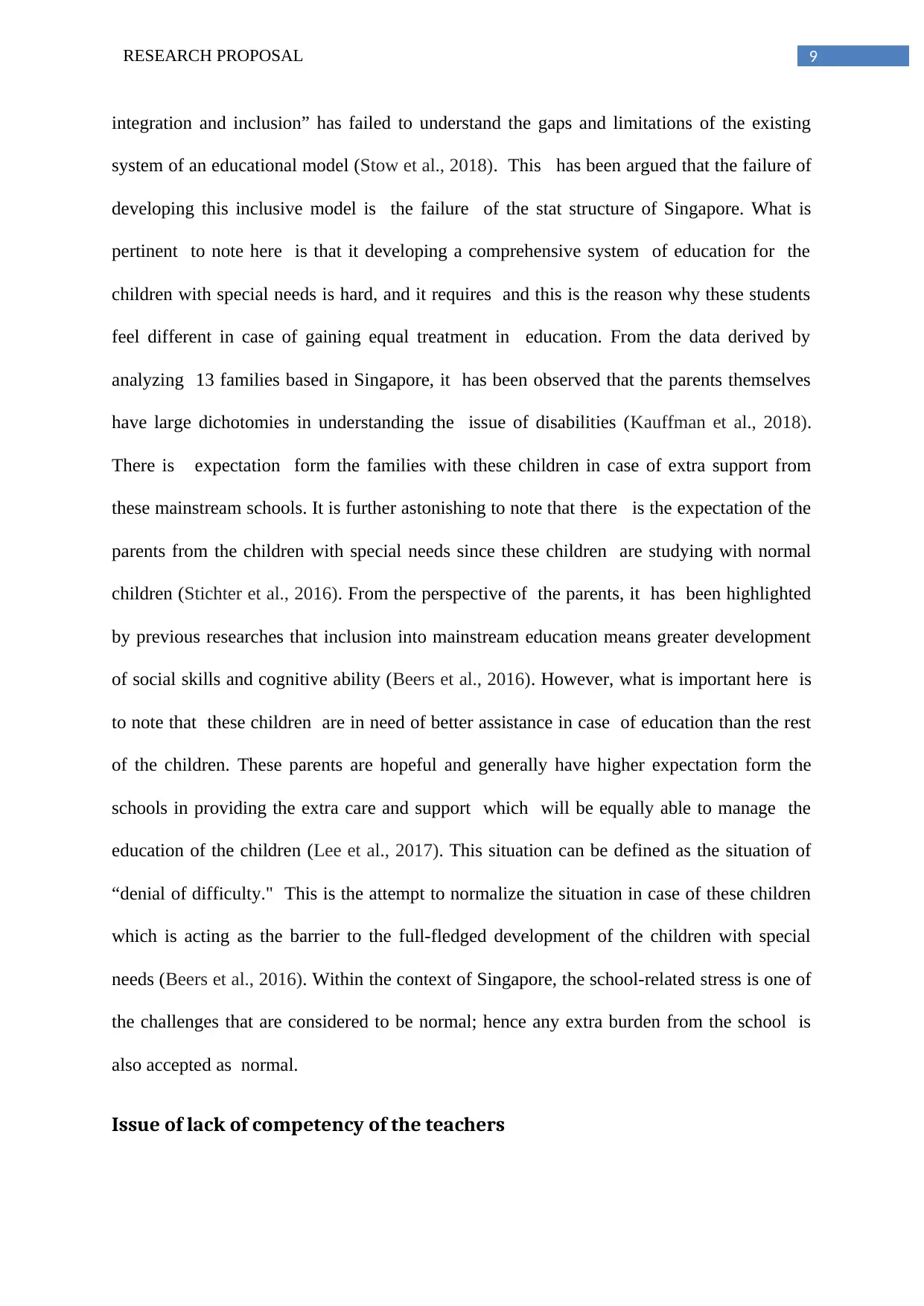
9RESEARCH PROPOSAL
integration and inclusion” has failed to understand the gaps and limitations of the existing
system of an educational model (Stow et al., 2018). This has been argued that the failure of
developing this inclusive model is the failure of the stat structure of Singapore. What is
pertinent to note here is that it developing a comprehensive system of education for the
children with special needs is hard, and it requires and this is the reason why these students
feel different in case of gaining equal treatment in education. From the data derived by
analyzing 13 families based in Singapore, it has been observed that the parents themselves
have large dichotomies in understanding the issue of disabilities (Kauffman et al., 2018).
There is expectation form the families with these children in case of extra support from
these mainstream schools. It is further astonishing to note that there is the expectation of the
parents from the children with special needs since these children are studying with normal
children (Stichter et al., 2016). From the perspective of the parents, it has been highlighted
by previous researches that inclusion into mainstream education means greater development
of social skills and cognitive ability (Beers et al., 2016). However, what is important here is
to note that these children are in need of better assistance in case of education than the rest
of the children. These parents are hopeful and generally have higher expectation form the
schools in providing the extra care and support which will be equally able to manage the
education of the children (Lee et al., 2017). This situation can be defined as the situation of
“denial of difficulty." This is the attempt to normalize the situation in case of these children
which is acting as the barrier to the full-fledged development of the children with special
needs (Beers et al., 2016). Within the context of Singapore, the school-related stress is one of
the challenges that are considered to be normal; hence any extra burden from the school is
also accepted as normal.
Issue of lack of competency of the teachers
integration and inclusion” has failed to understand the gaps and limitations of the existing
system of an educational model (Stow et al., 2018). This has been argued that the failure of
developing this inclusive model is the failure of the stat structure of Singapore. What is
pertinent to note here is that it developing a comprehensive system of education for the
children with special needs is hard, and it requires and this is the reason why these students
feel different in case of gaining equal treatment in education. From the data derived by
analyzing 13 families based in Singapore, it has been observed that the parents themselves
have large dichotomies in understanding the issue of disabilities (Kauffman et al., 2018).
There is expectation form the families with these children in case of extra support from
these mainstream schools. It is further astonishing to note that there is the expectation of the
parents from the children with special needs since these children are studying with normal
children (Stichter et al., 2016). From the perspective of the parents, it has been highlighted
by previous researches that inclusion into mainstream education means greater development
of social skills and cognitive ability (Beers et al., 2016). However, what is important here is
to note that these children are in need of better assistance in case of education than the rest
of the children. These parents are hopeful and generally have higher expectation form the
schools in providing the extra care and support which will be equally able to manage the
education of the children (Lee et al., 2017). This situation can be defined as the situation of
“denial of difficulty." This is the attempt to normalize the situation in case of these children
which is acting as the barrier to the full-fledged development of the children with special
needs (Beers et al., 2016). Within the context of Singapore, the school-related stress is one of
the challenges that are considered to be normal; hence any extra burden from the school is
also accepted as normal.
Issue of lack of competency of the teachers
Paraphrase This Document
Need a fresh take? Get an instant paraphrase of this document with our AI Paraphraser
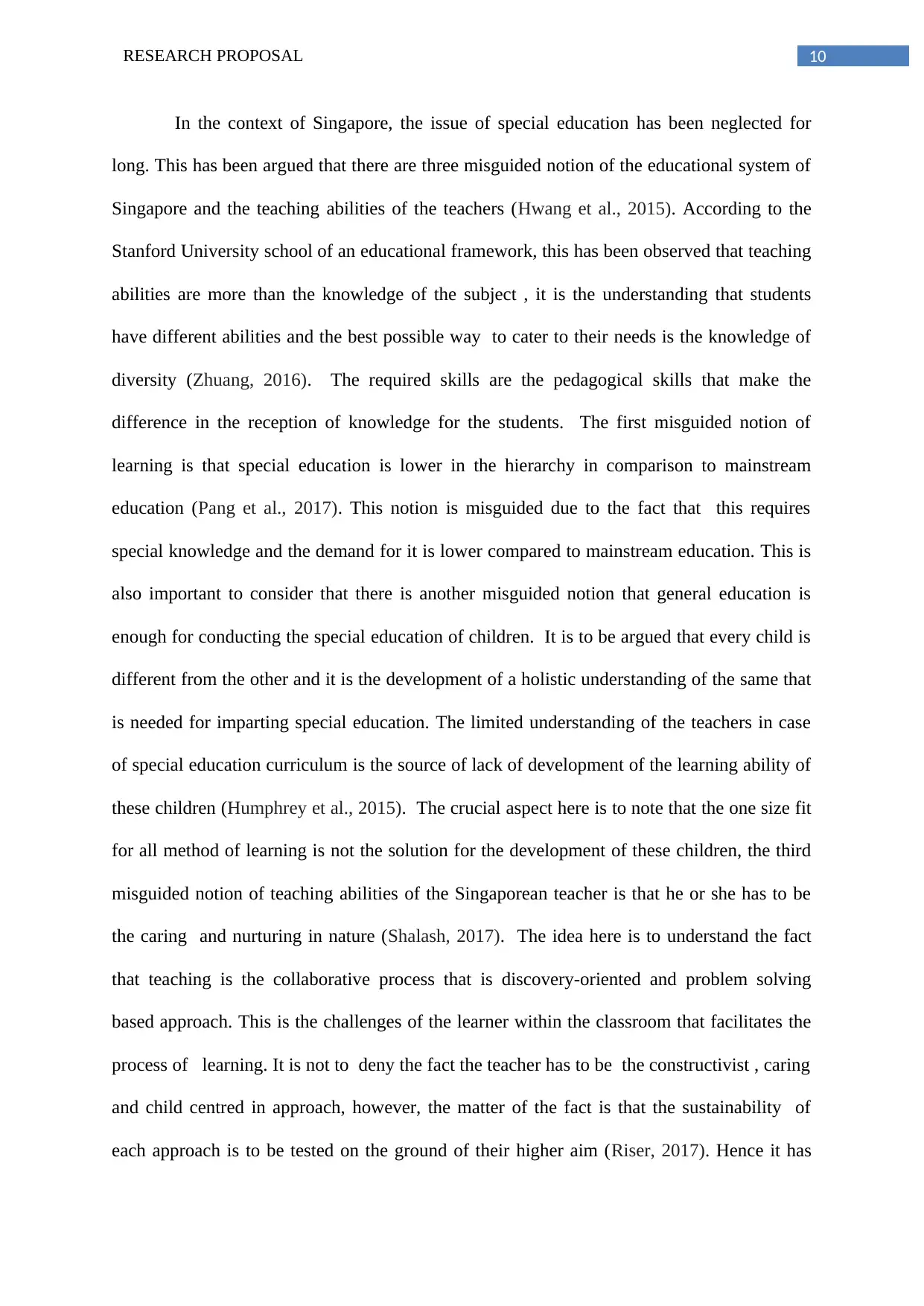
10RESEARCH PROPOSAL
In the context of Singapore, the issue of special education has been neglected for
long. This has been argued that there are three misguided notion of the educational system of
Singapore and the teaching abilities of the teachers (Hwang et al., 2015). According to the
Stanford University school of an educational framework, this has been observed that teaching
abilities are more than the knowledge of the subject , it is the understanding that students
have different abilities and the best possible way to cater to their needs is the knowledge of
diversity (Zhuang, 2016). The required skills are the pedagogical skills that make the
difference in the reception of knowledge for the students. The first misguided notion of
learning is that special education is lower in the hierarchy in comparison to mainstream
education (Pang et al., 2017). This notion is misguided due to the fact that this requires
special knowledge and the demand for it is lower compared to mainstream education. This is
also important to consider that there is another misguided notion that general education is
enough for conducting the special education of children. It is to be argued that every child is
different from the other and it is the development of a holistic understanding of the same that
is needed for imparting special education. The limited understanding of the teachers in case
of special education curriculum is the source of lack of development of the learning ability of
these children (Humphrey et al., 2015). The crucial aspect here is to note that the one size fit
for all method of learning is not the solution for the development of these children, the third
misguided notion of teaching abilities of the Singaporean teacher is that he or she has to be
the caring and nurturing in nature (Shalash, 2017). The idea here is to understand the fact
that teaching is the collaborative process that is discovery-oriented and problem solving
based approach. This is the challenges of the learner within the classroom that facilitates the
process of learning. It is not to deny the fact the teacher has to be the constructivist , caring
and child centred in approach, however, the matter of the fact is that the sustainability of
each approach is to be tested on the ground of their higher aim (Riser, 2017). Hence it has
In the context of Singapore, the issue of special education has been neglected for
long. This has been argued that there are three misguided notion of the educational system of
Singapore and the teaching abilities of the teachers (Hwang et al., 2015). According to the
Stanford University school of an educational framework, this has been observed that teaching
abilities are more than the knowledge of the subject , it is the understanding that students
have different abilities and the best possible way to cater to their needs is the knowledge of
diversity (Zhuang, 2016). The required skills are the pedagogical skills that make the
difference in the reception of knowledge for the students. The first misguided notion of
learning is that special education is lower in the hierarchy in comparison to mainstream
education (Pang et al., 2017). This notion is misguided due to the fact that this requires
special knowledge and the demand for it is lower compared to mainstream education. This is
also important to consider that there is another misguided notion that general education is
enough for conducting the special education of children. It is to be argued that every child is
different from the other and it is the development of a holistic understanding of the same that
is needed for imparting special education. The limited understanding of the teachers in case
of special education curriculum is the source of lack of development of the learning ability of
these children (Humphrey et al., 2015). The crucial aspect here is to note that the one size fit
for all method of learning is not the solution for the development of these children, the third
misguided notion of teaching abilities of the Singaporean teacher is that he or she has to be
the caring and nurturing in nature (Shalash, 2017). The idea here is to understand the fact
that teaching is the collaborative process that is discovery-oriented and problem solving
based approach. This is the challenges of the learner within the classroom that facilitates the
process of learning. It is not to deny the fact the teacher has to be the constructivist , caring
and child centred in approach, however, the matter of the fact is that the sustainability of
each approach is to be tested on the ground of their higher aim (Riser, 2017). Hence it has
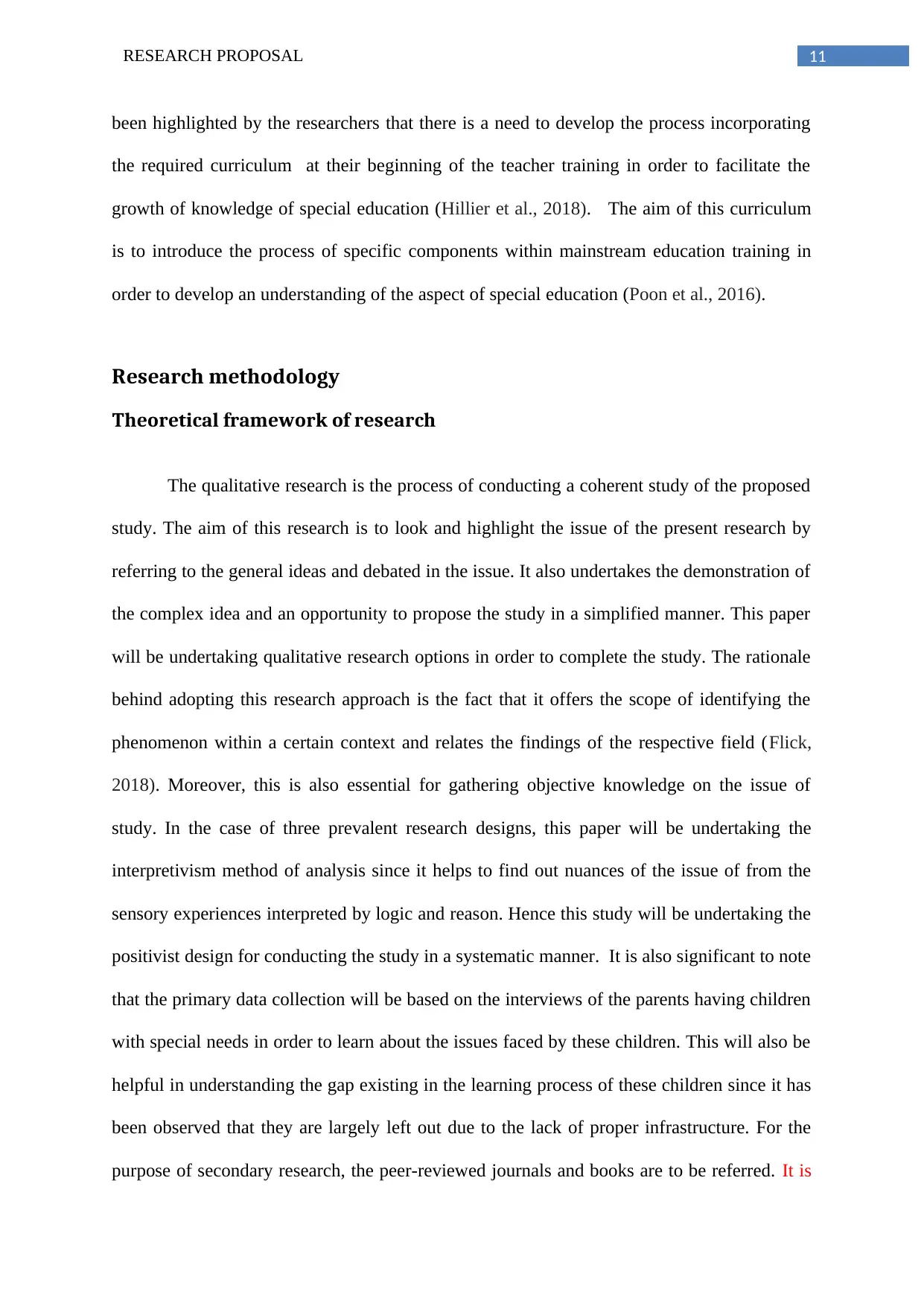
11RESEARCH PROPOSAL
been highlighted by the researchers that there is a need to develop the process incorporating
the required curriculum at their beginning of the teacher training in order to facilitate the
growth of knowledge of special education (Hillier et al., 2018). The aim of this curriculum
is to introduce the process of specific components within mainstream education training in
order to develop an understanding of the aspect of special education (Poon et al., 2016).
Research methodology
Theoretical framework of research
The qualitative research is the process of conducting a coherent study of the proposed
study. The aim of this research is to look and highlight the issue of the present research by
referring to the general ideas and debated in the issue. It also undertakes the demonstration of
the complex idea and an opportunity to propose the study in a simplified manner. This paper
will be undertaking qualitative research options in order to complete the study. The rationale
behind adopting this research approach is the fact that it offers the scope of identifying the
phenomenon within a certain context and relates the findings of the respective field (Flick,
2018). Moreover, this is also essential for gathering objective knowledge on the issue of
study. In the case of three prevalent research designs, this paper will be undertaking the
interpretivism method of analysis since it helps to find out nuances of the issue of from the
sensory experiences interpreted by logic and reason. Hence this study will be undertaking the
positivist design for conducting the study in a systematic manner. It is also significant to note
that the primary data collection will be based on the interviews of the parents having children
with special needs in order to learn about the issues faced by these children. This will also be
helpful in understanding the gap existing in the learning process of these children since it has
been observed that they are largely left out due to the lack of proper infrastructure. For the
purpose of secondary research, the peer-reviewed journals and books are to be referred. It is
been highlighted by the researchers that there is a need to develop the process incorporating
the required curriculum at their beginning of the teacher training in order to facilitate the
growth of knowledge of special education (Hillier et al., 2018). The aim of this curriculum
is to introduce the process of specific components within mainstream education training in
order to develop an understanding of the aspect of special education (Poon et al., 2016).
Research methodology
Theoretical framework of research
The qualitative research is the process of conducting a coherent study of the proposed
study. The aim of this research is to look and highlight the issue of the present research by
referring to the general ideas and debated in the issue. It also undertakes the demonstration of
the complex idea and an opportunity to propose the study in a simplified manner. This paper
will be undertaking qualitative research options in order to complete the study. The rationale
behind adopting this research approach is the fact that it offers the scope of identifying the
phenomenon within a certain context and relates the findings of the respective field (Flick,
2018). Moreover, this is also essential for gathering objective knowledge on the issue of
study. In the case of three prevalent research designs, this paper will be undertaking the
interpretivism method of analysis since it helps to find out nuances of the issue of from the
sensory experiences interpreted by logic and reason. Hence this study will be undertaking the
positivist design for conducting the study in a systematic manner. It is also significant to note
that the primary data collection will be based on the interviews of the parents having children
with special needs in order to learn about the issues faced by these children. This will also be
helpful in understanding the gap existing in the learning process of these children since it has
been observed that they are largely left out due to the lack of proper infrastructure. For the
purpose of secondary research, the peer-reviewed journals and books are to be referred. It is
⊘ This is a preview!⊘
Do you want full access?
Subscribe today to unlock all pages.

Trusted by 1+ million students worldwide
1 out of 24
Related Documents
Your All-in-One AI-Powered Toolkit for Academic Success.
+13062052269
info@desklib.com
Available 24*7 on WhatsApp / Email
![[object Object]](/_next/static/media/star-bottom.7253800d.svg)
Unlock your academic potential
Copyright © 2020–2025 A2Z Services. All Rights Reserved. Developed and managed by ZUCOL.




